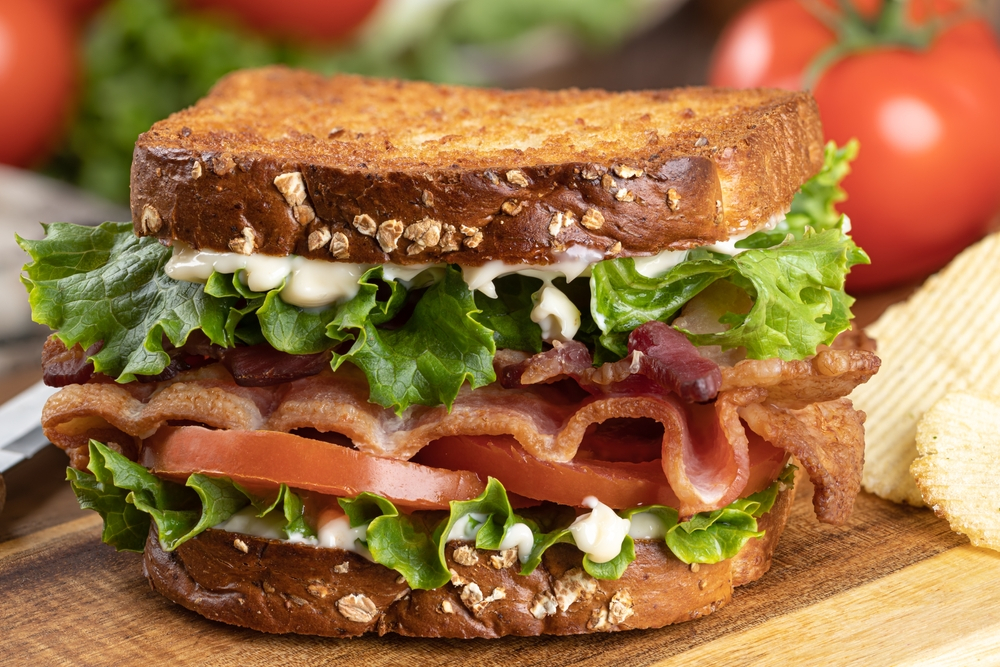This classic sandwich of bacon, lettuce, and tomato has been a staple of American diets for decades, but with health concerns surrounding processed meats; it’s time to take a closer look at the pros and cons of this beloved dish. In this article, we’ll dive into the question of whether or not BLTs are healthy and help you make an informed decision about whether to include this classic sandwich in your diet.
The History of the BLT.
The classic BLT sandwich – bacon, lettuce and tomato – has been a popular American favorite for generations. But the question remains, are BLTs healthy? It all depends on how you make it.
The classic version of this sandwich is typically made with bacon, lettuce, tomato and mayonnaise on white bread. But depending on your preferences and dietary needs, it can be adjusted to be a healthier option.
The origins of the BLT sandwich can be traced back to the early 1900s when people began to experiment with combining bacon and tomatoes.
While the first published recipe was featured in 1896 in Good Housekeeping magazine, it wasn’t until 1924 that the BLT as we know it today became popular.
In 1924, the chef at the Brown Derby restaurant in Los Angeles created a sandwich featuring bacon, lettuce and tomato.
Today, the BLT is a staple at delis and cafes across the country. It’s also one of the most popular comfort foods around. Whether you’re enjoying it for breakfast, lunch or dinner, the BLT is sure to hit the spot.
The Nutritional Facts.
When it comes to the question of whether or not BLTs are healthy, the answer is both yes and no. On the one hand, a BLT contains bacon, lettuce, and tomato, all of which are nutritious and provide various health benefits.
Bacon, for instance, is a source of protein, iron, B vitamins, selenium, and zinc. Lettuce is rich in fiber, vitamins A and K, and potassium. Tomatoes are an excellent source of lycopene, a powerful antioxidant.
On the other hand, the bacon in a BLT is usually processed with nitrates and other preservatives that can have negative health effects.
Plus, it is high in fat and sodium. Additionally, the white bread that typically surrounds a BLT adds refined carbohydrates to the equation. Refined carbohydrates can cause spikes in blood sugar levels and increase the risk of type 2 diabetes.

The 5 Pros of eating a BLT.
1. Easy to Make.
A BLT is one of the easiest sandwiches to make and can be ready in just minutes. It requires minimal ingredients, which makes it convenient for busy people on the go.
2. Low in Calories.
A typical BLT sandwich has around 300 calories, which is relatively low compared to other types of sandwiches.
3. Healthy Source of Protein.
The bacon in a BLT provides a healthy source of protein, helping you to stay fuller longer.
4. Versatile.
A BLT can be customized with different ingredients and condiments such as tomatoes, lettuce, cheese, mayonnaise, mustard, or avocado.
5. Tasty.
With the combination of crisp bacon and juicy tomatoes, a BLT is definitely a tasty meal option. The salty bacon and creamy mayonnaise add flavor to the sandwich.
However, if you want to keep your sandwich healthy, be sure to use low-fat condiments like mustard and watch your portion sizes.
The 5 Cons of eating a BLT.
1. High in Calories.
A traditional BLT sandwich can contain up to 735 calories, depending on the ingredients used. This can be high for those trying to watch their calorie intake.
2. High in Sodium.
The bacon alone in a BLT can contribute over 900 milligrams of sodium per serving. That is more than half of the daily recommended intake for sodium.
3. High in Saturated Fats.
A BLT contains both saturated fats from the bacon and trans fats from the mayonnaise. Both of these fats are considered bad for you and can raise your cholesterol levels and also lead to high heart risk if consumed in large amounts.(1)
4. Low in Fiber.
While a BLT does provide some essential vitamins and minerals, it is low in fiber. Fiber is important for digestion and helps to keep you full for longer.
5. Not the Healthiest Option.
As you can see, a BLT is not the healthiest option when it comes to sandwiches. It is high in calories, saturated fat, and sodium. Therefore, if you are looking for a healthy sandwich option, a BLT might not be the best choice.
Are BLTs Healthy?
When it comes to answering the question, “Are BLTs healthy?”, the answer is not necessarily yes or no. It depends on your dietary needs and preferences. However, if you are looking for a healthier option, there are other sandwiches that are better suited for your nutritional goals.
Best Alternatives of BLT Sandwich.
The best alternative of BLT sandwich are:
- Burger.
- Multigrain sandwich.
- Grilled Sandwich.
Frequently Asked Question.
No, it is not healthy for heart patients as its saturated fat content is quite high.
No, it is not good for weight loss as it contains high amount of sodium and fat.
Well there is a little bit tough choice to decide which one is healthy. But in order to check through fat content then it can be said that BLT is not healthy as it contains high amount of fat and sodium which is not at all good for health.
1 serving which is of 140g provides 447g of calories.
Not at all, as it will make baby difficult to digest thereby lead to poor health.
Bottom Line.
When it comes to the question of “Are BLTs healthy?”, the answer is that it really depends. Depending on the ingredients you use, a BLT can be a great source of nutrition and health benefits. But if you’re using overly processed and fatty ingredients, then a BLT may not be the healthiest choice. In general, eating a BLT in moderation can be part of a balanced diet. To make your BLT healthier, opt for whole wheat bread, fresh vegetables, lean turkey bacon, and low-fat mayonnaise. With these substitutions, you can enjoy the classic sandwich without overloading it with unhealthy fats and calories.
+1 Source
Freaktofit has strict sourcing guidelines and relies on peer-reviewed studies, educational research institutes, and medical organizations. We avoid using tertiary references. You can learn more about how we ensure our content is accurate and up-to-date by reading our editorial policy.
- Bacon, Hot Dogs and Lunch Meat – Is it Processed Meat?; https://www.aicr.org/resources/blog/bacon-hot-dogs-and-lunch-meat-is-it-processed-meat/
How we reviewed this article:
Our team of experts is always monitoring the health and wellness field, ensuring that our articles are updated promptly as new information emerges. See Our Editorial Process
May 23, 2025
Written By: Nebadita
Reviewed By: Laine Greenawalt
Written By: Nebadita
Reviewed By: Laine Greenawalt

 Workout
Workout

 Meditation
Meditation






 Podcast
Podcast
 E-book
E-book














